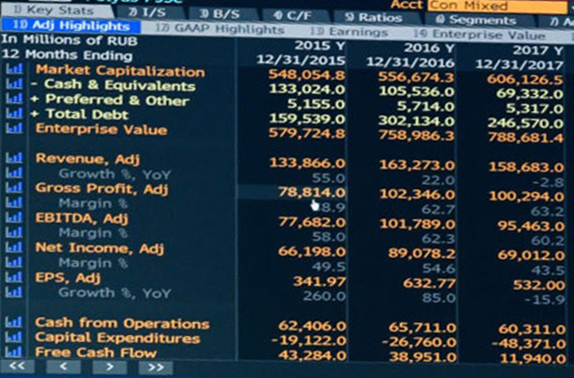Example of a P & L Statement,
reworded, recasted, and adjusted
for your Shareholders & new Investors,
for indepth analysis and comparison study.
INCOME from Manufacturing/Services/Trade
- COSTS directly related to Income: All P&L items in $/£/€/¥/₽/₹/元
- Material/parts from Inventory and as a % of INCOME
- Material/parts Purchases
- Manufacturing/Services Labor
- Sales/Services Costs/Commissions
- Subcontractors/Consultants
- All Freight in/out to wholesale/retail
- Other costs directly related to income
- Total COGS (Costs Of Goods Sold)
GROSS PROFIT from Sales/Operations
- COSTS Indirectly related to Income:
- VARIABLE COSTS:
- Bad Debt
- Sales Salaries
- R&D expenses
- Telecom expenses
- Overtime expenses
- Insurance Expenses
- Advertising/Promotion
- Various consumption taxes
- Fees (bank-legal-accounting)
- Training costs Human Capital
- Repairs/Renovations/Maintenance
- Travel/Car/Entertainment expenses
- Other Variable Expenses
- Total Indirect Variable Costs (also in %)
- FIXED (General & Admin) COSTS:
- Owners Salaries
- Admin Payroll
- R&D expenses
- Telecom expenses
- Insurance Expenses
- Rent & Lease expenses
- Facilities/Utilities Expenses
- Other Fixed G&A Expenses
- Total Indirect Fixed (G&A) Costs
- TOTAL INDIRECT COSTS from Operations
NET PROFIT from Operations
Other Income (Int., IP, Investments)
Expenses related to Other Income
NET PROFIT from all Performances (EBITDA) (also in %)
Depreciation/Amortization
NET PROFIT after Depreciation/Amortization (EBIT) (also in %)
Interest Expenses (loans, credits, etc.)
Corporate Taxes
POST-TAX PROFIT (PTP) or NET EARNINGS (E)
Preferred Dividend Pay-out
NET EARNINGS after PD Pay-out, and available as dividend
Direct Costs are costs that can be directly applied to a specific good or service. Any other cost is called an indirect cost.
Direct Costs are used to accurately assess the COGS, and Inventory that may be in different stages of production.
Gross Profit calculated for each product, is most useful for comparing companies in profitability.
A Semi-Fixed or semi-variable cost is an indirect cost that contains elements that are fixed as well as vary with Income.
Net Profit can be used to reinvesting, stockpiling, buying back shares, or paying a dividend to shareholders.
Financial accounting provides information to parties outside the organization, such as the government and investors.
Managerial accounting, also known as cost accounting, is a breakdown of the above listed elements. It is the process of identifying, measuring, analyzing, interpreting, and communicating information to managers for accurate decision making, in the pursuit of an organization's goals.
Managerial accounting is the main tool for the CFO, the Chief Financial Officer. It is used for the:
- Budget, a quantitative expression of the business’s Plan of Operation.
- Performance reports, which note deviations of actual results from that budget.
- Margin analysis, which shows the incremental benefit of a sales or production increase, by performing a break-even analysis, which involves calculating the contribution margin on the sales mix to determine the unit volume at which the business’s gross sales equal total expenditures. This information is useful for determining price points for products and services.
- Constraint Analysis, which determines where principle bottlenecks can occur, and calculate the impact of these constraints on revenue, profit, and cash flow.
- Capital Budgeting is used for capital expenditure decisions. These are metrics, such as net present value, payback period, and internal rate of return, to assist decisions whether to embark on capital-intensive projects or purchases, such as examining proposals, deciding if the products or services are needed, and finding the appropriate way to finance the purchase.
- Trend Analysis/Forecasting involves the reviewing of the trendline for certain costs, and investigating unusual variances or deviations. This field of accounting also utilizes previous period information to calculate and project future financial information. This may include the use of historical pricing, sales volumes, customer tendencies, geographical locations, or other financial information.
- Product Costing/Valuation determines the actual costs of products or services, by calculating and allocating overhead charges to assess the true expenses related to the production of a product. The overhead expenses may be allocated based on the quantity of goods produced or other drivers related to the production, such as the square foot of the facility.
- Cash Flow Statement (CFS). Whereas the CFS is the glue that brings the financial statements together, the Discounted Cash Flow (DCF) is a valuation method used to estimate the value of an investment based on its future cash flows. DCF analysis attempts to figure out the value of a company today, based on projections of how much money it will generate in the future. DCF analysis finds the present value of expected future cash flows using a discount rate WACC. A present value estimate is then used to evaluate a potential investment. If the value calculated through DCF is higher than the current cost of the investment, the opportunity should be considered.
The income statement shows the inflows and expenses used to generate those inflows, but no capital resources, like assets or equity. For that, we study the balance sheet.





